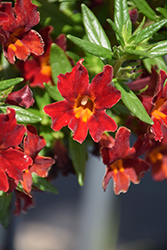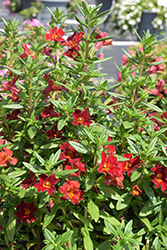Fri & Sat 8am - 8pm
Sun 8am - 7pm
Anytown, USA 12345
fax: 261.787.0463
e-mail: info@successgc.com


Plant Finder

Mai Tai Red Monkeyflower
Mimulus 'Mai Tai Red'
Height: 18 inches
Spread: 12 inches
Sunlight:
![]()
![]()
Hardiness Zone: 9a
Description:
A vigorous, easy to grow shrub featuring medium sized, dark red flowers with orange throats, appearing from early summer to fall, over lustrous dark green foliage; excellent for partly shaded rock gardens, or dry borders once established
Ornamental Features
Mai Tai Red Monkeyflower features showy clusters of lightly-scented dark red trumpet-shaped flowers with orange throats along the branches from early summer to mid fall. It has dark green evergreen foliage. The glossy narrow leaves remain dark green throughout the winter.
Landscape Attributes
Mai Tai Red Monkeyflower is a dense multi-stemmed evergreen shrub with a more or less rounded form. Its relatively fine texture sets it apart from other landscape plants with less refined foliage.
This shrub will require occasional maintenance and upkeep, and should only be pruned after flowering to avoid removing any of the current season's flowers. It is a good choice for attracting bees, butterflies and hummingbirds to your yard, but is not particularly attractive to deer who tend to leave it alone in favor of tastier treats. It has no significant negative characteristics.
Mai Tai Red Monkeyflower is recommended for the following landscape applications;
- Mass Planting
- Rock/Alpine Gardens
- General Garden Use
- Groundcover
- Naturalizing And Woodland Gardens
- Container Planting
Planting & Growing
Mai Tai Red Monkeyflower will grow to be about 18 inches tall at maturity, with a spread of 12 inches. It tends to fill out right to the ground and therefore doesn't necessarily require facer plants in front. It grows at a medium rate, and under ideal conditions can be expected to live for approximately 20 years. As this plant tends to go dormant in summer, it is best interplanted with late-season bloomers to hide the dying foliage.
This shrub does best in full sun to partial shade. You may want to keep it away from hot, dry locations that receive direct afternoon sun or which get reflected sunlight, such as against the south side of a white wall. It is very adaptable to both dry and moist growing conditions, but will not tolerate any standing water. It is considered to be drought-tolerant, and thus makes an ideal choice for a low-water garden or xeriscape application. This plant will benefit from an application of bonemeal and/or mycorrhizal fertilizer at the time of planting. It is not particular as to soil pH, but grows best in sandy soils. It is somewhat tolerant of urban pollution, and will benefit from being planted in a relatively sheltered location. This particular variety is an interspecific hybrid.
Mai Tai Red Monkeyflower makes a fine choice for the outdoor landscape, but it is also well-suited for use in outdoor pots and containers. It is often used as a 'filler' in the 'spiller-thriller-filler' container combination, providing a mass of flowers against which the thriller plants stand out. Note that when grown in a container, it may not perform exactly as indicated on the tag - this is to be expected. Also note that when growing plants in outdoor containers and baskets, they may require more frequent waterings than they would in the yard or garden.

